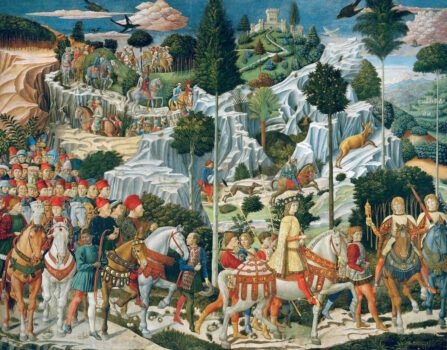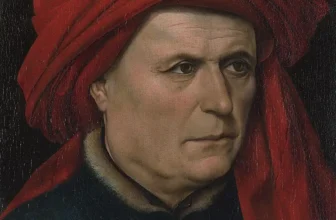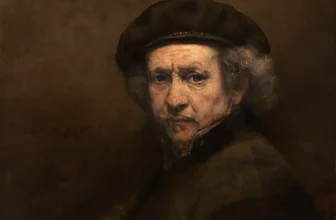The Journey of the Magi by Benozzo Gozzoli
Benozzo Gozzoli’s The Journey of the Magi is a monumental fresco cycle that stands as a jewel of the Italian Renaissance. Painted between 1459 and 1461, this work is located in the Magi Chapel of the Palazzo Medici-Riccardi in Florence. Its sumptuous detail, vibrant color, and opulent procession have captivated viewers for centuries. But beyond its visual splendor lies a wealth of historical, political, and religious symbolism that enriches our understanding of the painting and the era in which it was created. This analysis explores the meaning of The Journey of the Magi, delving into its narrative, symbolism, style, and current location, to offer a comprehensive understanding of this Renaissance masterpiece.
What Is The Journey of the Magi All About?
At its surface, The Journey of the Magi recounts the Biblical story of the Three Wise Men traveling to Bethlehem to pay homage to the newborn Christ. Yet, Gozzoli’s frescoes transform this narrative into a grand procession of noble figures, many of whom were contemporaries of the artist and members of the powerful Medici family. The cycle consists of three walls depicting the journey: the east wall features Melchior, the youngest Magus; the west wall portrays Balthasar, the middle Magus; and the south wall shows Caspar, the oldest of the three.
Gozzoli’s depiction deviates from a strict religious narrative. Instead of focusing on the nativity or the moment of adoration, the fresco immerses the viewer in the long, ceremonial pilgrimage of the Magi, rich in pageantry. The result is not merely a religious scene but a grand parade that honors Florence’s elite, fuses sacred story with secular magnificence, and reflects the Medici’s desire to project themselves as wise, pious, and powerful rulers.
Symbolism and Interpretation
Gozzoli’s work is a tapestry of complex symbolism that reflects Renaissance ideals, religious devotion, and political ambition.
1. The Three Magi
Traditionally, the Magi represent three ages of man and three known continents, Europe, Asia, and Africa. Gozzoli’s fresco respects this symbolism but incorporates additional layers. Each Magus is believed to be modeled on a contemporary figure:
- Melchior is often identified with Lorenzo de’ Medici (Lorenzo the Magnificent), portrayed as a youthful, radiant figure leading the procession. This identification suggests the Medici’s alignment with divine wisdom and guidance.
- Balthasar may represent another Medici or allied noble, possibly Giuliano de’ Medici.
- Caspar, the eldest, is thought to resemble the Holy Roman Emperor Sigismund or another dignitary, which implies the Medici’s political reach beyond Florence.
2. The Procession
The elaborate train of attendants, animals, and courtiers represents more than just a journey, it’s a visual declaration of power. The luxurious garments, the exotic animals (leopards, camels, monkeys), and the intricate landscapes allude to the vast wealth and cosmopolitan nature of the Medici dynasty. The real-life attendees in the fresco, including foreign ambassadors and allies of the Medici, reinforce their international influence.
3. Landscapes and Architecture
The detailed Tuscan hills in the background serve both an artistic and symbolic purpose. They root the Biblical story in a recognizable Florentine context, blending sacred time with contemporary geography. Architecture resembling Florentine buildings further reinforces the notion that the Magi’s journey reflects the Medici’s spiritual and civic journey.
4. Costume and Ornamentation
Every garment and piece of jewelry is painted with precision. These details are not merely decorative; they are assertions of wealth and taste. The Renaissance humanist ideals of beauty, order, and learning are encapsulated in these textiles and accessories, symbolizing the virtues of a cultured, well-governed society, ideals the Medici claimed to embody.
What Is Happening in the Painting?
The fresco cycle does not show a single event but rather captures a continuous narrative across three walls. The Magi, accompanied by their courts, journey through a rugged yet serene landscape towards the unseen site of the Nativity. The viewer’s eye is drawn into the composition through winding roads, elegant trees, and rhythmic clusters of figures.
Unlike earlier religious art that focused on iconographic stillness, Gozzoli’s Journey is dynamic. Horses prance, falcons fly, pages whisper, and kings ride. This is a world in motion, a world filled with courtly etiquette, diplomacy, and grandeur.
Within this movement lies a deeper message: the journey itself is the focal point, not the destination. This aligns with Renaissance humanist thought, which valued the process of learning, growth, and civic participation as a means of reaching moral and spiritual enlightenment.
What Type of Art Is It?
The Journey of the Magi is a fresco, a mural painting technique where pigments are applied to wet plaster. This method allows for vibrant colors and durability, suitable for the decorative schemes of Renaissance palaces and chapels.
Stylistically, the fresco belongs to the Early Renaissance, though it contains elements of the International Gothic style, particularly in its ornate detail, use of gold, and stylized figures. Gozzoli’s training under Fra Angelico and collaboration with Ghiberti on the bronze doors of the Florence Baptistery contributed to his technical skill and narrative clarity.
The fusion of Gothic elegance with Renaissance perspective and realism marks The Journey of the Magi as a transitional work, bridging medieval iconography with the emerging ideals of humanism and naturalism.
Where Is the Painting Located Today?
The Journey of the Magi fresco cycle remains in its original location: the private chapel of the Palazzo Medici-Riccardi in Florence, Italy. The palace, designed by Michelozzo, was commissioned by Cosimo de’ Medici in the 1440s as both a family residence and a public symbol of Medici power.
The chapel was intended as an intimate space for worship but also functioned as a visual manifesto of Medici prestige. Visitors to the palace would be escorted to this small but splendid room to witness not just a religious scene, but the glorification of the Medici through sacred narrative.
Today, the Palazzo is a museum open to the public, and the chapel stands as a remarkably well-preserved example of Renaissance fresco painting. Despite some damage and restoration over the centuries, Gozzoli’s frescoes retain their color, detail, and emotional impact, continuing to attract scholars, tourists, and art lovers alike.
A Renaissance Masterpiece of Power and Piety
Benozzo Gozzoli’s The Journey of the Magi is far more than a decorative religious painting. It is a carefully orchestrated visual symphony that combines religious devotion with political ambition, artistic innovation with historical documentation. Through the sumptuous procession of the Magi, Gozzoli conveys not only the Biblical journey but also the journey of the Medici themselves, rising from merchant bankers to de facto rulers of Florence.
The fresco cycle celebrates the pageantry of faith and the nobility of intellect, mirroring the Renaissance ideals of harmony between the divine and the human. In doing so, it provides modern viewers with a window into the cultural and political heart of 15th-century Florence, making it a cornerstone of Italian Renaissance art. Its enduring allure lies in this very synthesis: the sacred and the secular, the personal and the universal, the historical and the eternal. image/historytoday




